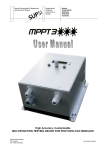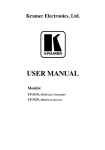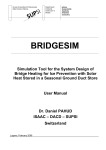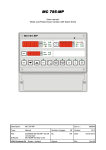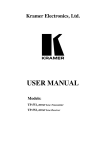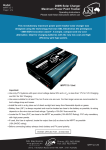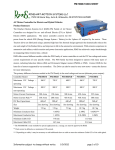Download "user manual"
Transcript
High Accuracy, Customizable MULTIFUNCTION TESTING DEVICE FOR PHOTOVOLTAIC MODULES SUPSI-DACD-ISAAC Campus Trevano CH - 6952 Canobbio www.isaac.supsi.ch SUPSI – DACD – ISAAC MPPT3☼☼☼ - User Manual september.2011 TABLE OF CONTENTS Important safety notice ....................................................................................................................3 Short description ..............................................................................................................................4 Applications ......................................................................................................................................4 Technical specifications ..................................................................................................................5 Performance ......................................................................................................................................5 Box and connections........................................................................................................................6 Front ..............................................................................................................................................6 Mounting the MPPT300..................................................................................................................7 Top lateral ......................................................................................................................................8 Bottom lateral .................................................................................................................................8 Wiring description and schematics.................................................................................................9 Choose of the load resistor ...........................................................................................................28 How to chose a load resistor ........................................................................................................28 Reachable MPP tracking efficiency vs. output load resistor.........................................................28 Table how to calculate the load resistor .......................................................................................30 RS485 network ................................................................................................................................31 Connections system, pin configuration and caracteristics............................................................38 Connections schematics ..............................................................................................................38 Turning on the MPPT3000..............................................................................................................37 Turning off the MPPT3000..............................................................................................................37 Menu.................................................................................................................................................38 Device and Accessories.................................................................................................................40 Software MPPT3K Manager 2.5.3 ..................................................................................................43 Main commands ...........................................................................................................................44 Display online values....................................................................................................................45 Data logging .................................................................................................................................46 Remote IV curve control...............................................................................................................47 Setup ............................................................................................................................................49 Terminal .......................................................................................................................................51 MPP Adjustment ..........................................................................................................................52 MPPT Full Search schema...........................................................................................................53 User Manual - ENG V1.7.doc 2/56 SUPSI – DACD – ISAAC MPPT3☼☼☼ - User Manual september.2011 Important safety notice Warning : In all cases the assembly and installation must be done by qualified technicians, observing the national requirements and rules stipulated. Opening the MPPT3000 or using it incorrectly will result in the immediate loss of the warranty, (unless for upgrades in agreement with manufacturer) Warranty: 1 year. Limitation of liability : ISAAC - SUPSI cannot control the installation, use and maintenance of the MPPT3000. Thus, we are not responsible for damages, costs or losses resulting from an installation which is not in accordance with the regulations or inappropriate use or maintenance. The customer is always responsible for the use of the MPPT3000 and any other related additional device. This device has not been designed nor warranted for use in any critical apparatus with potential risks of serious harm to people or to the environment. ISAAC - SUPSI reserves the right to modify their products without previous notice. User Manual - ENG V1.7.doc 3/56 SUPSI – DACD – ISAAC MPPT3☼☼☼ - User Manual september.2011 Short description The MPPT 3000 is a multifunction testing device for photovoltaic modules. A photovoltaic module, when connected to the MPPT 3000, is set to work in a MPP tracking mode. The MPPT 3000 also allows a customized I-V Tracer function. It is possible to connect RTD temperature sensors, pyranometers or other external sensors. The interaction with the MPPT is possible directly using its LCD and buttons or through a simple graphical user interface. The PV module energy is dissipated using an external resistor load with heat sink that must be always connected. This device has been developed for specific PV module testing at the ISAAC - SUPSI laboratory (TISO group). − − − − − − − − − − − − − accurate MPP tracking: maximum 0.5 % error on PMPP tracking wide voltage and current scalable ranges: up to 200V / 20A / max 250W optoisolated analog auxiliary outputs in order to measure, using an external measurement system, the PV module working condition and the auxiliary sensors built-in independent data logging: internal data storage allowing the use of the MPPT as datalogger transportable, compact, wide operating ambient temperature range (from -20°C to +40 °C) galvanically isolated RS-485 interface: dialog between PC master and one or more MPPTs I-V Tracer : use of the MPPT3000 as settable IV Tracer simultaneous Im and Vm measurement non isolated analog output (optional) run-time selectable ranges (automatic or manual) possibility to measure, thanks to a built-in micro-converter and independently from data loggers or external peripherals, the main meteorological parameters (T, G, …) by means of auxiliary sensors (sensors are not included) user friendly management software IP 20 case Applications This electrical equipment is extremely useful for anyone who needs to accurately test photovoltaic modules such school laboratories, module manufacturers or module providers, testing laboratories and so on. Typical applications are: − − − − − sc-Si, mc-Si, a-Si, thin-film accurate module testing I-V characterization Energy production test and comparison at outdoor real conditions Meteorological measurements during module test Comparison of an existing PV plant behaviour with respect to a reference PV module under test using the MPPT3000. User Manual - ENG V1.7.doc 4/56 SUPSI – DACD – ISAAC MPPT3☼☼☼ - User Manual september.2011 Technical specifications General MPPT power supply Operating ambient temperature Case protection grade Load output resistor Dimensions Weight Photovoltaic module values PMAX in VMAX @ 250W ISC MAX Vm MIN Measurements Voltage measurement ranges Current measurement ranges °C Ω mm kg +24VDC / 8 W +/-10% from -20 to +40 IP20 from 18 to 47 (Load must always be connected !) 194 x 221 x 162 without cableglands nor cables 5 W V A V 250 (continuous); 150 5 / 10 / 20 (depends on the model) 5 V 200 / 100 / 50 / 25 20A Model: 20 / 10 / 5 /2.5 10A Model: 10 / 5 / 2.5 /1.25 5A Model: 5 / 2.5 / 1.25 / 0.625 0.2 A Accuracy % IV Tracer Scan rate min 2/3/4/5/6 Points number 128 / 256 / 512 Sweep Time s 1.0 to 3.0 IV tracing ad hoc available using the MPPT manager software. MPP Tracker Full I-V curve search Types Fast MPP fine adjust Control Power and voltage Customizable MPP adjust and Vm adjust available. Auxiliary opto-isolated analog outputs from 0 to 10 (proportional to the default represented 4 analog outputs (Vm, Im, RTD 1, RTD 2) VDC input ranges) Short circuit protected outputs. High impedance load required. Auxiliary analog measurement inputs Auxiliary input 1 RTD only (PT100) Auxiliary input 2 RTD only (PT100) Auxiliary input 3 voltage 0…1V max (autorange from 0..10mV to 0..1V) Galvanically isolated RS-485 port Bit rate bps 115200 Data length bit 8 Stop bit bit 1 Parity Even Flow control None Performance MPP Tracking Static MPP tracking efficiency Dynamic MPP tracking efficiency IV Tracer IV tracing difference DC / DC conversion Typ. Efficiency (Pout/Pin) % % > 99.5 > 98.0 % ±0.2 % 90.0 This performance test has been carried out at specific conditions, please see the specific data-book for details. User Manual - ENG V1.7.doc 5/56 SUPSI – DACD – ISAAC MPPT3☼☼☼ - User Manual september.2011 Box and connections Front - Power supply - Display backlight ESC MENU ENTER - The reset button of the main part (DSP) is placed on the left side of the box. - On the right side, there is the reset button of the auxiliary part (μController). When accessing a reset button, please use a non-conductor stick. User Manual - ENG V1.7.doc 6/56 SUPSI – DACD – ISAAC MPPT3☼☼☼ - User Manual september.2011 Mounting the MPPT3000 The MPPT3000 is provided with integrated heat sink for power dispersion. In order to get maximum power dispersion the box must be mounted in vertical position or with a maximum tilt of 30° from vertical position , see also following schematics. Moreover please allow 1 cm minimum gap from heat sink to mounting wall. min 10mm min 10mm max 30° Mounting schematics The electrical operating temperature of the MPPT goes from -20°C to +70°C but the ambiance temperature must not exceed 40°C at maximum power (250 W) User Manual - ENG V1.7.doc 7/56 SUPSI – DACD – ISAAC MPPT3☼☼☼ - User Manual september.2011 Top lateral 1 4 2 3 5 Bottom lateral 6 8 7 User Manual - ENG V1.7.doc 8/56 SUPSI – DACD – ISAAC MPPT3☼☼☼ - User Manual september.2011 Wiring description Connector 1 2 3 4 5 6 7 8 Description RS-485 line, DB9 male RS-485 line, DB9 female Auxiliary analog outputs, DB9 female Auxiliary input/output of auxiliary part (μController), DB15 male Power supply of MPPT3000 Input for PV voltage sense measurement Input for power connection PV module Output power part (to the load resistor) WARNING! THE LOAD RESISTOR MUST ALWAYS BE CONNECTED TO THE MPPT3000 ! Using the MPPT3000 without the load resistors leads to serious damages. Connector 1 and 2 : See chapter RS-485 line. Connector 3 : 1 2 Output AUX1 (0...10V represents 0...Ufull scale) Output AUX1 (GND) 3 4 Output AUX2 (0...10V represents 0...Ifull-scale) Output AUX2 (GND) 5 6 Output AUX3 (0...10V represents 0...AUX_Ch0_full scale) Output AUX3 (GND) 7 8 Output AUX4 (0...10V represents 0...AUX_Ch1_full scale) Output AUX4 (GND) 9 not connected All auxiliary outputs are short circuit protected by means of a 2 kΩ series resistor. Therefore to measure the output voltage value high impedance input instruments are required. User Manual - ENG V1.7.doc 9/56 SUPSI – DACD – ISAAC MPPT3☼☼☼ - User Manual september.2011 Connector 4 : Auxiliary measurement part (μC) inputs. Configuration : _ RTD on AUX IN 1 (AUX_Ch0) _ RTD on AUX IN 2 (AUX_Ch1) _ general voltage input on AUX IN 3 The next picture shows how to connect the RTDs and the general purpose voltage input (typically a pyranometer). IEXC 1 9 PT100 AUX IN 1 => AUX OUT 3 & DISPLAY AUX IN 2 => AUX OUT 4 & DISPLAY AUX IN 3 => DISPLAY 2 10 3 11 PT100 4 12 13 Max 1 VDC 6 AUX IN 3: The minimum voltage input range is 0..10 mV, the maximum voltage input range is 0..1V. The input range selection is automatic, just avoid to exceed 1 VDC or the device will be damaged . The voltage must be always positive (unipolar). The MPPT itself provides the excitation current for the RTDs. In the following annexes (A to I) you find all the possibility how to do right connections. User Manual - ENG V1.7.doc 10/56 SUPSI – DACD – ISAAC MPPT3☼☼☼ - User Manual september.2011 A- AUX-IN CONNECTION Æ 2xPT100, 1x Sensor[V] with intermediaries clamps and shield connected together User Manual - ENG V1.7.doc 11/56 SUPSI – DACD – ISAAC MPPT3☼☼☼ - User Manual september.2011 B- AUX-IN CONNECTION Æ 2xPT100, 1x Sensor[V] with intermediaries clamps and shield connected together User Manual - ENG V1.7.doc 12/56 SUPSI – DACD – ISAAC MPPT3☼☼☼ - User Manual september.2011 C- AUX-IN CONNECTION Æ 2xPT100, 1x Sensor[V] with intermediaries clamps and shield split User Manual - ENG V1.7.doc 13/56 SUPSI – DACD – ISAAC MPPT3☼☼☼ - User Manual september.2011 D- AUX-IN CONNECTION Æ 2xPT100, 1x Sensor[V] with intermediaries clamps and shield split User Manual - ENG V1.7.doc 14/56 SUPSI – DACD – ISAAC MPPT3☼☼☼ - User Manual september.2011 E- AUX-IN CONNECTION Æ 1xPT100, 1x Sensor[V] with intermediaries clamps and shield connected together User Manual - ENG V1.7.doc 15/56 SUPSI – DACD – ISAAC MPPT3☼☼☼ - User Manual september.2011 F- AUX-IN CONNECTION Æ 1xPT100, 1x Sensor[V] and shield connected together User Manual - ENG V1.7.doc 16/56 SUPSI – DACD – ISAAC MPPT3☼☼☼ - User Manual september.2011 G- AUX-IN CONNECTION Æ 1xPT100, 1x Sensor[V] with intermediaries clamps and shield split User Manual - ENG V1.7.doc 17/56 SUPSI – DACD – ISAAC MPPT3☼☼☼ - User Manual september.2011 H- AUX-IN CONNECTION Æ 1xPT100, 1x Sensor[V] and shield split User Manual - ENG V1.7.doc 18/56 SUPSI – DACD – ISAAC MPPT3☼☼☼ - User Manual september.2011 I- AUX-IN CONNECTION Æ 1xPT100 with intermediaries clamps and shield connected together User Manual - ENG V1.7.doc 19/56 SUPSI – DACD – ISAAC MPPT3☼☼☼ - User Manual september.2011 Connector 5 - Power Supply - Simply connect 2:1 connector to the Power 24V of the MPPT. - The AC 220V has to be connected only after the Load, PV and Sense. User Manual - ENG V1.7.doc 20/56 SUPSI – DACD – ISAAC MPPT3☼☼☼ - User Manual september.2011 Connectors 6 and 7: PV Module power (Input) - Voltage Sense (Input) - Check the voltage and the polarity of the photovoltaic module. - The voltage of the photovoltaic module should in any case NOT exceed the value of 200 VDC (Voc voltage). - These connections should be done very carefully observing the polarity, any inappropriate voltage or polarity can damage the device. - All the PV wires for 20A must to be minimum 2.5mm2, greater is better because you have less losses. - The Sense wires 0.25mm2 - The Sense connections have to be connected with the PV connections near as possible to the module. The shied of the sense has to arrive till the the PV connection, but it isn’t to be connected! User Manual - ENG V1.7.doc 21/56 SUPSI – DACD – ISAAC MPPT3☼☼☼ - User Manual september.2011 A- Connection MC3 (MPPT3000)- MC3 (PV-Module) + white _ brown This connection solution is the more easier to assembly and simple if you have to change or dismount the system, but the most expensive.With the MPPT3000 we supply only the ‘Sense’ connector and cable. The cost of the Multi-Contact accessories will be around 60-70 EUR, depending on the length of the cables User Manual - ENG V1.7.doc 22/56 SUPSI – DACD – ISAAC MPPT3☼☼☼ - User Manual september.2011 Connection MC3 (MPPT3000)- MC3 (PV-Module) +White _ brown This connection solution is to weld or crimp the sense wirings directly with the MC3 connectors. You have to weld yourself the MC connector with the cables ‘PV’and ‘Sense’, but is cheaper than the first solution. With the MPPT3000 we supply only the ‘Sense’ connector and cable. The cost of the Multi-Contact accessories will be around 30-40 EUR, depending on the length of the cables. User Manual - ENG V1.7.doc 23/56 SUPSI – DACD – ISAAC MPPT3☼☼☼ - User Manual september.2011 C-Connection MC3 (MPPT3000)- MC4 (PV-Module) + white _ brown This connection solution is exactly as the solution ‘A’, but with MC4 connectors The costs are similar. User Manual - ENG V1.7.doc 24/56 SUPSI – DACD – ISAAC MPPT3☼☼☼ - User Manual september.2011 D-Connection MC3 (MPPT3000)- MC4 (PV-Module) + white - brown _ This connection solution is exactly as the solution ‘B’, but with MC4 connectors. The costs are similar. User Manual - ENG V1.7.doc 25/56 SUPSI – DACD – ISAAC MPPT3☼☼☼ - User Manual september.2011 E-Connection MC3 (MPPT3000)- without (PV-Module) + white - brown _ Clamp 200VDC 20A This connection solution is the faster and cheaper, but is the less secure, do to the clamp that has to be isolated!!! . User Manual - ENG V1.7.doc 26/56 SUPSI – DACD – ISAAC MPPT3☼☼☼ - User Manual september.2011 Cable 8 : LOAD (Output) IIM MP EC PO OR CO RTTA ON NN AN NE NTT :: TTH EC CTTE ED D !!!!!!!!!!!! HE E LLO OA AD DM MU US STT A ALLW WA AY YS SB BE Load connection : The load MUST always be connected. Using the MPPT3000 without the load resistors leads to serious damages. There is no polarity. User Manual - ENG V1.7.doc 27/56 SUPSI – DACD – ISAAC MPPT3☼☼☼ - User Manual september.2011 Choose of the load resistor How to chose a load resistor A load resistor must always be connected to the power output of the MPPT3000. Please chose a resistor value between 18 and 47 Ω in order to : _ not to exceed Iout (I load) < 3.5 A DC _ not to exceed Vout (V load) < 108 V DC according to the power output to disperse. Example : Power of module = 250 W Vmpp max > 5 V ( ex : 17 V) I mpp max < 20 A (ex : 14.7 A) R load min = 250 / (3.52) = 20.4 Ω R load max = (1082) / 250 = 46.6 Ω Æ thus we choose for example 33 Ω / 250 W (or more powerfull) Æ check in the two charts below if the value of R load chosen is within required parameters Example of resistor to use : HS series heatsink mount resistors - Resistance range R005 to 100K Ohms - To 600W - Tolerance from 0.5% - High power to volume ratio - All welded construction - Available in Non-Inductive Style (Type N) - High pulse withstand capability - Connection variation available Æ REMEMBER TO MOUNT LOAD RESISTORS ON A SUITABLE HEAT SINK Reachable MPP tracking efficiency vs. output load resistor The maximum power point tracking efficiency depends also on the chosen output load resistor. As mentioned in the previous sub-chapter, the value of this resistor can vary between 18 and 47 Ω. The following charts show the MPP tracking efficiency limits vs. output load resistor. User Manual - ENG V1.7.doc 28/56 SUPSI – DACD – ISAAC MPPT3☼☼☼ - User Manual september.2011 Iin = f(Uin) with maximum MPP tracking error percentage limits using 18 Ω output resistor 100 Iin [A] 10 1 Inside the area limited by this lines, the MPPT can reach the 99.5 % of MPP tracking efficieny (0.5% error). 0.1 1 5V limit 0.5 10 100 1000 Uin [V] 0.5 1 1 1.5 1.5 2 2 250W Limit Iin = f(Uin) with maximum MPP tracking error percentage limits using 47 Ω output resistor 100 Iin [A] 10 1 Inside the area limited by this lines, the MPPT can reach the 99.5 % of MPP tracking efficieny (0.5% error). 0.1 1 5V limit 0.5 10 100 1000 Uin [V] 0.5 1 1 1.5 1.5 2 2 250W Limit It can be seen that most of the working area is inside the by the black lines, which describe the 99.5 % efficiency limits. Only in extreme conditions the efficiency can go slightly below this limit. However, if the MPPT is used properly, the declared MPP tracking efficiency is respected, as it has been proved during the MPPT practical test. User Manual - ENG V1.7.doc 29/56 SUPSI – DACD – ISAAC MPPT3☼☼☼ - User Manual Table how to calculate the load resistor User Manual - ENG V1.7.doc 30/56 september.2011 SUPSI – DACD – ISAAC MPPT3☼☼☼ - User Manual september.2011 RS485 network The MPPT3000 devices can be connected to a master PC through a RS485 network. In this way it is possible to fully exploit the potential of the device using the specific user friendly management software. The following scheme shows the correct wiring of the MPPT3000 to the RS485 network. USB USB-RS485 Terminator ... RS485 F M F M F M M F M F M F MPPT 3000 #001 MPPT 3000 #002 MPPT 3000 #NNN At the end of the RS485 line there must be a terminal resistor, which can varies depending on the manufacturer of the USB/RS485 adapter and on the cables length. This terminal resistor must be wired between pin 1 (DATA+) and pin 9 (DATA–) of the DB9 connector. DB9 for RS232 pinout1 Data Carrier Detect RxD TxD Data Terminal Ready Signal Ground Data Set Ready Request to Send Clear to Send Ring Indicator Pin 1 2 3 4 5 6 7 8 9 DB9 for RS485 pinout2 DATA+ Not connected Not connected Not connected GND V+ Not connected Not connected DATA- To dialog with one or more MPPTs use only the “MPPT Manager” software. This software allows the user to manage one or more MPPTs easily. RS-485 Standard Physical Media Network Topology Maximum Devices Maximum Distance Mode of Operation Maximum Baud Rate Voltage Levels Mark(1) Space(0) Available Signals 1 2 EIA RS-485 Twisted Pair Point-to-point, Multi-dropped, Multi-point 32 drivers or receivers 1200 metres (4000 feet) Differential 100 kbit/s - 10 Mbit/s -7 V to +12 V Positive Voltages (B-A > +200 mV) negative voltages (B-A < -200 mV) Tx+/Rx+, Tx-/Rx- (Half Duplex) Tx+, Tx-, Rx+, Rx- (Full Duplex) Defined by the RS232 standard. Selected for the MPPT3000 project. User Manual - ENG V1.7.doc 31/56 SUPSI – DACD – ISAAC MPPT3☼☼☼ - User Manual Connections schematics User Manual - ENG V1.7.doc 32/56 september.2011 SUPSI – DACD – ISAAC User Manual - ENG V1.7.doc MPPT3☼☼☼ - User Manual 33/56 september.2011 SUPSI – DACD – ISAAC User Manual - ENG V1.7.doc MPPT3☼☼☼ - User Manual 34/56 september.2011 SUPSI – DACD – ISAAC User Manual - ENG V1.7.doc MPPT3☼☼☼ - User Manual 35/56 september.2011 SUPSI – DACD – ISAAC User Manual - ENG V1.7.doc MPPT3☼☼☼ - User Manual 36/56 september.2011 SUPSI – DACD – ISAAC MPPT3☼☼☼ - User Manual september.2011 Turning on the MPPT3000 1. After wiring the device according to the manual specifications, unplug the PV module from the MPPT3000. 2. Verify that the full-scale voltage (Ufull scale) and the full-scale current (Ifull scale) are never exceeded. Every time a PV module is replaced, verify again that the settings for Ufull scale and Ifull scale are correct. If these requirements are met, go to 7. 3. Turn the device on and wait until the default writing appears on the display3. 4. Set the Ufull scale and Ifull scale in order that the PV module never exceeds the chosen values. The set-up can be done directly on MPPT3000 or on the graphical interface of the provided software. 5. Save the settings for Ufull-scale and Ifull-scale. Here again this can de done directly on the MPPT3000 or by the software. 6. Turn the MPPT3000 off. 7. Turn the device on and wait until the default writing appears on the display4. 8. Verify that the settings for Ufull-scale and Ifull-scale have been loaded correctly. 9. Plug the PV module to the device. 10. At this stage, the MPPT is operating and can communicate with the master PC through the provided software, performing the requested instructions. Turning off the MPPT3000 To switch the MPPT off is recommended to use the shutdown command, this command disables the data logging and prepares the MPPT to be switched off. 1. 2. 3. 4. Open the MPPT Manager software. Select the Terminal Folder. Press the “Shutdown” button. Wait the MPPT answer. Now is safe to turn off the MPPT3000. Note: After the shutdown command is sent, the data logging is disabled. To restore the normal function mode the MPPT must be restarted either switching off and re-switching on the power supply or using the reset button. 3 The time necessary for starting (software load to the processor and initialization) may varies slightly but it is generally about 30 sec. 4 See previous remark. User Manual - ENG V1.7.doc 37/56 SUPSI – DACD – ISAAC MPPT3☼☼☼ - User Manual september.2011 Menu on the MPPT’s display Introduction about the MPPT Menu Three alphanumeric characters help the user to browse the menu. The first character is used to define the level (Level 0 → no sign, Level 1 → single point, Level 2 → 2 points). The second and the third characters show the position number of the selected lower level. Examples: 1 2 0 2 2 0 2 2 1 3 0 0 This is an indicative representation, not a full representation. ' ' " 0 0 0 0 2 2 1 3 Level 0 is the higher level, it represents the main groups. Level 1 is the level used to browse and select the voices inside a main group. Level 2 is the lower level, when the user is in this level he can modify the chosen voice. Only the voices that are available in level 2 can be modified directly through the MPPT. Only the most important voices can be modified directly using the MPPT interface (buttons and scroll). The other voices are only accessible using the MPPT Manager software, which also provides an easy access to all the features of the MPPT3000. Menu Levels Scroll Description 1 2 3 4 5 6 7 8 9 10 11 12 13 14 15 16 ESC Enter 0 1 2 Default 0 0 0 0 0 0 0 0 0 0 0 0 0 1 0 0 2 0 0 3 0 0 4 0 Um, Pm (Normal functioning) Im, Power part duty cycle Um, Pm (Power adjustment) Im, Power part duty cycle Um, Pm (Voltage adjustment) Im, Duty Cycle Um, Pm (MPP full search) Im, Power part duty cycle Date, Week day Hour E tot E day PV module Type DSP Software version uController Software version x x x x x x x x d h E E M a D x x x x x x x x d h t d o b S u x x x x x x x x . : x x d c P C . . . . . . . . m m x x u d x x x x x x x x m m x x l e S S x x x x x x x x . : x x e f W W y s x x g V A V A V A V A y s x x T h x x → x x ← x x # x # x A x x x x x x x x b x x y i a a x . x W h x . x W h e k l m n o p c d e f g h c d e f g h x x p j b b x x x x x x x x c . . . . . . . . x x x x x x x x W % W % W % W % Next Nothing Next / Previous L0 Next Nothing Next / Previous L0 Next Nothing Next / Previous L0 Next Nothing Next / Previous L0 Next Nothing Next / Previous L0 Next Nothing Next / Previous L0 Next Nothing Next / Previous L0 Next Nothing Next / Previous L0 Level UP Level DOWN Next / Previous L0 Level UP Level DOWN Next / Previous L1 Level UP (don't load in RAM) Enter Change state Level UP Nothing Next / Previous L1 Level UP Nothing Next / Previous L1 Level UP Nothing Next / Previous L1 Level UP Nothing Next / Previous L1 Level UP Nothing Next / Previous L1 Low Refresh Info 1 99 0 1 0 0 1 0 1 1 1 0 1 2 0 1 3 0 1 4 0 1 5 0 1 6 0 1 7 0 1 8 0 1 9 0 1 10 0 1 11 0 1 12 0 1 13 0 1 14 0 1 15 0 1 15 1 1 16 0 1 16 1 1 17 0 1 17 1 1 18 0 1 19 0 1 20 0 1 1 21 22 0 0 RS485 network ID PV module manufacturer PV module type PV module serial number PV module database ID PV module ID code PV module position Auxiliary output 2 external datalogger associated channel Auxiliary output 3 external datalogger associated channel PV module MPP power @ STC. L o w R e f r e s h I n f o ( S e t u p 1 M P P T I D S e t M P P T M a M a S a D a b o b e b a n c d c r c t M a P a C o b o b h d c d s i c d u d u d i d a C h @ PV module MPP current @ STC. I m @ PV module MPP voltage @ STC. V m @ PV module short circuit current @ STC I PV module open circuit voltage @ STC V o c PV module fill factor. F F MPPT current mesuring shunt resistor. R s h u n s c I D f a c t u r e r e f g h i j k l l e T y p e e f g h i j k l a l N r e f g h i j k l b M o d I D x x I D C o d e e f g h i j k l t i o n e f g h i j k l A u x 2 x x A u x 3 x x S T C x x x . S T C x x x . S T C x x x . @ S T C x x x . @ S T C x x x . P m x x x . S e t V R a n g e Default current range (Auxiliary output 1 refers to this value) I S R s h u n t V PV module cell area C PV module area M PV module cells in serie C PV module cells in parallel C e l l Output resistor R o u t User Manual - ENG V1.7.doc s m m x m m x x x x x x x x i n x t x R a n g x R a n g e x x x e t I R a n g x x x e l l A r e a x x x . o d u l e A r e x x x . e l l s i n s S e m t x Default voltage range (Auxiliary output 0 refers to this value) 0 1 ) x x x x e x x . . . x x e . x x x a x e x p a x x x r x r x x x x 38/56 ' x " x ' n ' n ' n ' x ' n ' n ' x ' x ' x ' x ' x ' x ' x ' x ' 0 x 0 x 0 o 0 o 0 o 0 x 0 o 0 o 0 x 0 x 0 1 1 1 1 1 1 m " 0 m ' 1 x " 0 x ' 1 x " 0 x ' 1 c m ' 1 m ' 2 x x ' 2 x x ' 2 x 0 x 1 x 1 p 2 p 3 p 4 x 5 p 6 p 7 x 8 x 9 W 0 A 1 V 2 A 3 V 4 % 5 Ω 1 Ω 6 V 1 V 7 A 1 A 8 2 9 2 0 x 1 x 2 Ω Level UP Nothing Next / Previous L1 Level UP Nothing Next / Previous L1 Level UP Nothing Next / Previous L1 Level UP Nothing Next / Previous L1 Level UP Nothing Next / Previous L1 Level UP Nothing Next / Previous L1 Level UP Nothing Next / Previous L1 Level UP Nothing Next / Previous L1 Level UP Nothing Next / Previous L1 Level UP Level DOWN Next / Previous L1 Level UP (don't load in RAM) Enter Change state Level UP Level DOWN Next / Previous L1 Level UP (don't load in RAM) Enter Change state Level UP Level DOWN Next / Previous L1 Level UP (don't load in RAM) Enter Change state Level UP Nothing Next / Previous L1 Level UP Nothing Next / Previous L1 Level UP Nothing Next / Previous L1 Level UP Nothing Next / Previous L1 Level UP Level DOWN Next / Previous L1 SUPSI – DACD – ISAAC MPPT3☼☼☼ - User Manual september.2011 Setup 2 2 99 0 0 0 2 0 1 2 1 0 2 1 1 2 2 0 2 2 1 2 3 0 2 3 1 2 4 0 2 4 1 2 5 0 2 5 1 2 6 0 2 6 1 2 7 0 2 7 1 2 8 0 2 8 1 2 9 0 2 9 1 2 10 0 2 10 1 2 11 0 2 11 1 2 12 0 2 12 1 2 13 0 2 14 0 2 15 0 2 16 0 2 16 1 2 17 0 2 18 0 2 18 PWM duty cycle manual setting. (use this only for debug purposes) MPP full search. H i g h R e f r e s h I n f o ( S e t u p 2 M a n u a l P W M x x x x x x M P P S e MPP full search type MPP full search scan rate MPP full search sweep time MPP full fearch dead time MPP adjustement state (ON/OFF) . . t M P P M P P S T M R S S M S S S M D S D M e y P a e c P w e w P e e e P t p P t t a P e t e P a t a P S e t MPP adjustement start window M P P MPP adjustement end window S S M Voltage adjustement state (ON/OFF) S E V x x x V x x x A F S F S x x x x F S M P P F S e F S S c a n e n e e d d M P R F S p M P p F S T M P T A d P a t t F S e x x x x x . T P T F S x x . x x F S x x . x P . A d A d S x A x E x A x V m x x x x A d x d x W x j x W x j x i n x x x x i n x x x Voltage adjustement end window S S V Automatic IV Tracer state (ON/OFF) S E I S S I R I e t I V T r t a t e V T r S c a n a t e x x h V T r P o i n t s I V Main datalogging scan rate Autorange state (ON/OFF) Restore default setup 1 x j W x e t V m A d j W i n x m A d j E W x e t V m A d j W i n x V T r S t a t T j x d x j V m Ad hoc IV Tracer points number (Automatic IV Tracer always has 256 pts) IV Tracer seweep time x j M P P A d x Voltage adjustement start window Automatic IV Tracer Scan Rate . . T y p e j x e t M P P W i n x P P A d j x e t M P P W i n x m A d j S e x x 0 2 ) S i n x x x x x x i n x x x x x e x x r D R S L A S w e e p T x x . a t a L o g g i n g a t e x e t D a t a o g g i n g R a t e x u t o r a n g e R D P t e s t o r e e f a u l t S e r e s s E n t e o R e s t o r e S D S i P t L i P t S i P t L i P t a S a n r o o n r o a n r o o n r o t r u p S e ' 0 0 x x ' A " A ' W % 1 C 1 C 2 x 1 x 3 s 1 s 4 s 1 s 5 s 1 s 6 C 1 C 7 x 1 x 8 x 1 x 9 C 1 C 0 x 1 x 1 x 1 x 2 C 1 C 3 m 4 x 5 s 6 m 1 m 7 C 0 x x 0 B 0 B 0 x " 0 x ' 0 x " 0 x ' 0 x " 0 x ' 0 x " 0 x ' 0 A B " 0 A B ' 0 x x " 0 x x ' 0 x x " 0 x x ' 0 A B " 0 A B ' 1 x x " 0 x x ' 1 x x " 0 x x ' 1 A B " 0 A B ' 1 x ' 1 x x ' 1 x ' 1 x " 0 x ' 1 A B ' 2 ? " 0 t u 1 p Level DOWN Next / Previous L0 Level UP Level DOWN Next / Previous L1 Level UP Change Quad Encoder Step Change Duty Cycle B Level UP Level DOWN Next / Previous L1 Level UP (don't load) Load into RAM Change state Level UP Level DOWN Next / Previous L1 Level UP (don't load) Enter Load into RAM Change state Level UP Level DOWN Next / Previous L1 Level UP (don't load) Enter Load into RAM Change state Level UP Level UP Level DOWN Next / Previous L1 Level UP (don't load) Enter Load into RAM Change state Level UP Level DOWN Next / Previous L1 Level UP (don't load) Enter Load into RAM Change state Level UP Level DOWN Next / Previous L1 Level UP (don't load) Load into RAM Change state Next / Previous L1 Level UP Level DOWN Level UP (don't load) Load into RAM Change state Level UP Level DOWN Next / Previous L1 Level UP (don't load) Load into RAM Change state Level UP Level DOWN Next / Previous L1 Level UP (don't load) Load into RAM Change state Level UP Level DOWN Next / Previous L1 Level UP (don't load) Load into RAM Change state Level UP Level DOWN Next / Previous L1 Level UP (don't load) Load into RAM Change state Level UP Level DOWN Next / Previous L1 Level UP (don't load) Load into RAM Change state Level UP Nothing Next / Previous L1 Level UP Nothing Next / Previous L1 Level UP Nothing Next / Previous L1 Level UP Level DOWN Next / Previous L1 Level UP (don't load) Load into RAM Change state Level UP Level DOWN Next / Previous L1 Level UP Level DOWN Next / Previous L1 Level UP (don't restore) Restore default LRI into RAM Nothing Level UP Level DOWN Next / Previous L0 Save/Load 3 99 0 3 0 0 3 0 1 3 1 0 3 1 1 3 2 0 3 2 1 3 3 0 3 3 1 Save Low Refresh Info (Setup1) into MPPT flash memory Load Low Refresh Info (Setup1) from flash memory to MPPT RAM Save High Refresh Info (Setup2) into MPPT flash memory Load High Refresh Info (Setup2) from flash memory to MPPT RAM v P v t e / L P a L F s a v L D s o a S F s a v S D s o a o r R l E e R S E d e l E e e S E d a d t I a s h n t e L R I P R n t e L R t u p a s h n t e S e t u p P R n t e S e u C o n v e r t e r x ° C x x V x x x a t e v t e a t e e e o s S d o s L e o s S d o s L 0 3 ' 0 0 A b c " 0 1 ? r I ' 0 1 A M ? A b c r " 0 1 I ' 0 2 ? r " 0 1 t u p ' 0 3 A M ? A b c r " 0 1 t u p Level UP Level DOWN Next / Previous L1 Level UP (don't save) Enter (Save) Nothing Level UP Level DOWN Next / Previous L1 Level UP (don't load) Enter (Load) Nothing Level UP Level DOWN Next / Previous L1 Level UP (don't save) Enter (Save) Nothing Level UP Level DOWN Next / Previous L1 Level UP (don't load) Enter (Load) Nothing Level UP Level DOWN Next / Previous L0 Level UP Nothing Next / Previous L1 uConverter 4 99 0 4 0 0 T ch0, T ch1 U ch3, T internal sensor User Manual - ENG V1.7.doc x x x . . x x x x 39/56 0 4 x x . . x x x x ° C ° C SUPSI – DACD – ISAAC MPPT3☼☼☼ - User Manual Device & Accessories included: 1) 2) 3) 4) 5) 6) MPPT3000 Device MPPT3000 User Manual MPPT3K Manager Software (CD and user Manual) power supply 24V load cable 1.5m sense cable 1.5m extras (on demand): 7) MC connectors or assembled cablings 8) Customized Load with ARCOL resistors 9) PT100 (temperature sensor) 10) Wiring and clamps to connect 2 PT100 and 1 phyranometer 11) RS485 Æ USB converter (ADAM) 12) RS485 Æ USB converter (Trinamic) 13) RS485 Æ MPPT3000 cable and connectors 10.0m (or only connectors) 14) AUX-IN cable configurated 1.0m (or only connectors) User Manual - ENG V1.7.doc 40/56 september.2011 SUPSI – DACD – ISAAC MPPT3☼☼☼ - User Manual september.2011 8 11 3 2 10 4 13 14 1 9 7 User Manual - ENG V1.7.doc 6 5 41/56 SUPSI – DACD – ISAAC User Manual - ENG V1.7.doc MPPT3☼☼☼ - User Manual 42/56 september.2011 SUPSI – DACD – ISAAC MPPT3☼☼☼ - User Manual september.2011 Software for SUPSI – DACD – ISAAC 2011 MPPT3K simple graphical user interface User Manual - ENG V1.7.doc 43/56 SUPSI – DACD – ISAAC MPPT3☼☼☼ - User Manual september.2011 MPPT3K Manager MPPT3K Manager is an utility that allows to remotely control an MPPT 3000 device, and to easily perform tasks that otherwise would require a terminal program and a deep knowledge of the MPPT 3000 communication protocols. The communication with the MPPT 3000 is done via the RS-485 port (normally an adapter USB <-> RS485 is utilized, see MPPT 3000 manual for more information). NOTE: This manual does not intend to explain how to test photovoltaic modules, but only to explain the program functionalities. Main Commands: A1 A2 A3 A4 A5 A6 A1. Tab selector Clicking on this area gives access to the five main areas of the program: - Online values: show data that is currently measured by the MPPT - Data logging: store data measured by the MPPT with an adjustable time step - Remote IV curve control: allows to request the MPPT to execute IV curves - Setup - Terminal A2. Serial port for RS485 or adapter This control allows to select the port that connects the PC with the MPPTs (via RS-485 or adapter) Note: this field is editable, click on the text to modify it with another port number A3. MPPT number To communicate with a specific MPPT, it is necessary to insert its identification number in this field A4. Status led The led is green when the program is ready The led is grey when the program is communicating or computing The led is red when an error occurs (e.g. communications errors) Note: It is not possible to communicate with a MPPT when the device is adjusting the MPP, executing an IV-tracer, executing a full MPP search or internal special sub-routines A5. Close the program Stop the execution of MPPT3K manager A6. Information button Open a window with information about the software User Manual - ENG V1.7.doc 44/56 SUPSI – DACD – ISAAC MPPT3☼☼☼ - User Manual september.2011 DISPLAY ONLINE VALUES: This section of the program gives the access to the values currently measured from the connected device. It is also possible to plot multiple measurements to visualize variations. B3 B4 B5 B6 B1 B2 B1. Pyranometer sensibility Set the pyranometer sensibility to show the correct irradiance values in W/m² B2. Refresh online values Retrieve the values currently measured from the selected MPPT. These values are shown on the left panel and added to the plot B3. Show plot buttons Show/hide selected plots B4. Clear Clear the graph B5./B6. Auto refresh When activated, the online values are automatically fetched every N seconds. The refresh frequency is set in the refresh every N seconds (B6) box. User Manual - ENG V1.7.doc 45/56 SUPSI – DACD – ISAAC MPPT3☼☼☼ - User Manual september.2011 DATA LOGGING: This function allows to retrieve and store data from the MPPT with an adjustable frequency. C1 C2 C3 C4 C5 C6 C7 C1. Output path selection Set the output .cvs file C2. Time between measurements Set the frequency between measurements in minutes C3. MPPT selection When using the datalogging function, the MPPT Nr. (A3) control box is disabled. Instead, it is possible to select multiple MPPTs to query, adding their identification number to the list. Remark: always consider the communication time between the program and the MPPT: when selecting a large number of MPPTs, the time between measurements (C2) has to be adjusted to avoid that a new cycle of queries will begin before the end of the current one. Remark: each MPPT is queried sequentially, so do not expect to obtain measurements from multilple MPPTs exactly at the same time C4. Check selected MPPT This function checks the values entered in the previous list (C3). If an MPPT number does not correspond to a reachable MPPT, the program asks to remove it from the list. C5. Start/Stop buttons Use these buttons to start/stop data acquisition C6. Current measurements window Shows data acquired during execution C7. Errors list Connection errors are shown in this list User Manual - ENG V1.7.doc 46/56 SUPSI – DACD – ISAAC MPPT3☼☼☼ - User Manual september.2011 REMOTE IV CURVE CONTROL: The MPPT3K Manager allows to execute remote ad-hoc IV curve measurements. It is possible to save the output values to file, and to plot graphs. This Ad-hoc IV curve has not to be confused with the IVtracer function embedded in the MPPT (for this feature see the setup section, MIVE commands). Note: The periodically MPPT3K IV-curve execution feature of the MPPT3K is not available yet. D1 D2 D3 D4 D5 D6 D7 D8 D9 D10 D11 D1. Multiple MPPT IV Curve To execute an ad-hoc IV Curve on multiple MPPTs, insert the identification number of the devices in the array. The IV curve will be executed on every selected MPPT sequentially (not in the same time!). If the array is empty, the IV Curve will be executed on the MPPT selected in MPPT number (A3) control box. Use button Empty array (D3) to empty the array D2. Execute IV Begin the execution of the IV curves D3. Empty array and use main MPPT number Use this button to empty the array Multiple MPPT IV curve (D1) D4. Autoexecute When activated, an IV curve is executed every N seconds, where N is the value set in # seconds countdown (D6) D5. Read from file Read a measurement file previously stored and plot the graph User Manual - ENG V1.7.doc 47/56 SUPSI – DACD – ISAAC MPPT3☼☼☼ - User Manual september.2011 D6. # seconds countdown Select the seconds between each IV curve (used only with autoexecute (D4)) D7. Graph title Insert a title for the printed graph D8. Select printer Select the printer for the print (D11) function D9. Open measure “.csv” Open a selected .csv file in excel (excel must be installed) D10. Delete measure “.csv” Delete a selected .csv file D11. Print Print the IV curves shown on the chart on the left IV tracer headers Data received from a MPPT via RS-485: BEGIN 09:51 MPPT: 1 10/05/07/ 4 09:51:43 50 1.25 0 0 0 0.012 -246.702 0.04 0,000000 1,144043 0,000000 1,144043 0,000000 1,144165 … … SweepTime: BEGIN [time] MPPT: [mppt number] [date] [day (1=mon, 2=tue, …)] [time] – SweepTime: [IV Sweep Time] [Um_coef ] [Im_coef] [aux0_unit_code] [aux1_unit_code] [aux2_unit_code] [aux_value0] [aux_value1] [aux_value2] [iv_U] [iv_I] … [iv_U] [iv_I] 2000 //multiplication coefficient* //not used yet //meteo data (T1, T2, G) * The values received from the MPPT need to be multiplied by a coefficient to obtain a correct value (this multiplication is already done by the MPPT3K manager) User Manual - ENG V1.7.doc 48/56 SUPSI – DACD – ISAAC MPPT3☼☼☼ - User Manual september.2011 SETUP: Setup allows to manage the most important settings of the MPPT3K (MPP search, IV-Tracer and Energy settings). It is also possible to setup informations about the modules that are connected to the device. These settings are stored in the MPPT RAM and are saved into the MPPT flash memory. E20 E1 MPP Full Search E2 E3 MPP Adjust E4 E5 E6 E7 Vm Adjust IV tracer E8 E9 E23 E10 E11 E12 E13 E14 E21 E22 E15 E16 E17 E18 E19 E1. Low refresh info (LRI) Read or set the values of the low refresh information (see MPPT user manual for more details) E2. Quick disable all Disable MPP Adjust, Vm Adjust, IV tracer and MPP full search on the MPPT3K. This can be useful, when communicating with the MPPT, to avoid communication problems (the MPPT3K doesn’t respond when executing MPP adjusting, commands, and other internal sub-routines). E3. Quick enable all Enable all the adjustment and search features on the MPPT E4./E6. Download main datalogger data (Main=module / uC=meteo) Download the stored datalogger values to a file in file store location (E22) The all/last switch allows to select the download mode It is possible to change the rate that these informations are stored, changing the value of the field Datalogging rate. File row format: Date;time;E.Total;E.Day;Vm;Im / Date;time;IN1;IN2;IN3 E5./E7. Download all/last When the option all is selected, all the datalogger memory is downloaded from the MPPT. When last is selected, the program reads the last measure present in the output file, and downloads only the missing measurements. Warning: If the datalogging rate has been changed use download all (E5/E7) to avoid data loss. User Manual - ENG V1.7.doc 49/56 SUPSI – DACD – ISAAC MPPT3☼☼☼ - User Manual september.2011 In both modes data is added to the previous downloaded data file, if present. E8. Get MPPT time Ask date and time to the MPPT3K Real Time Clock E9. Set MPPT time Sets the time of the PC to the MPPT E10. Enable buttons Enable following critical/special buttons (E11, E12, E13, E14) SPECIAL BUTTONS: ATTENTION: The following buttons will permanently erase the selected MPPT memory! E11. Reset daily energy Reset the daily energy counter E12. Reset total energy Reset the total energy counter E13. Erase energy flash blocks Erase all flash blocks where datalogger data is stored E14. Restore default setup (in MPPT ram) Restore the default MIVE setup in ram. The MPPT internal flash memory is not modified. Warning: Use save (E15) to store default values into the flash too, or at the next reboot of the device, old flash data will be charged into the ram E15. LRI management GET: fetch LRI values from MPPT RAM, and display them into the MPPT3K manager SET: load LRI values from the MPPT3K manager to the MPPT RAM SAVE: Save MPPT3K RAM LRI values to the flash (in the next reboot these values will be charged in MPPT RAM) LOAD: fetch MPPT3K LRI flash values, and set to the MPPT3K MPPT RAM E16. Save LRI to file Download MPPT3K LRI RAM values to the MPPT3K manager, and store them into a file E17. Read LRI from file Read LRI information from a file, and show them in the MPPT3K manager E18. Save MIVE to file Download MPPT3K MIVE RAM values to the MPPT3K manager, and store them into a file E19. Read MIVE from file Read MIVE information from a file, and show them in the MPPT3K manager E20. MPP search, IV-tracer and Energy (MIVE) Read or set the values of the MPP, IV-tracer and energy (MIVE). See MPPT user manual for more information E21. MIVE management GET: fetch MIVE values from MPPT3K RAM, and displays them into the MPPT3K manager SET: load MIVE values from the MPPT3K manager to the MPPT3K RAM SAVE: Save MPPT3K RAM MIVE values to the flash (at the next reboot these values will be charged in MPPT RAM) LOAD: fetch MPPT3K MIVE flash values, and set to the MPPT3K MPPT RAM E22. File store location Directory where IV Curve, datalogger values, and settings files are stored E23. Decimal sep International settings: Use “.” or “,” as decimal separator in the datalogging csv files User Manual - ENG V1.7.doc 50/56 SUPSI – DACD – ISAAC MPPT3☼☼☼ - User Manual september.2011 TERMINAL: This is an integrated remote terminal, for communicating with the selected MPPT. IMPORTANT: The terminal should be used only by trained personnel F2 F1 F3 F4 Note: When using the Terminal, all other MPPT3K manager functions are disabled F1. Send Send the command to the selected MPPT3K (A3.) F2. Read Activate the button to read responses on the serial port F3. Erase Delete history from the response window F4. Shutdown MPPT Prepare the MPPT to be switched off Example of that can be executed in the terminal: Format: ‘command’’values’ Example: 170 (PING, communication test) Example: 48010 (read last 10 datalog values) User Manual - ENG V1.7.doc 51/56 SUPSI – DACD – ISAAC MPPT3☼☼☼ - User Manual september.2011 MPP ADJUSTMENT MPP and Vm Adjust Pm ADJUST (MPP Adjust): Is a local search used to correct irradiation variations more than 0.5% (with default start window). Tested every 200ms Vm ADJUST: Is a local search used to correct temperature variations more than 0.5% (with default start window). Tested every 200ms This two adjustments are enough to follow the MPP in every conditions, but for morning, shadow or other conditions a third control is suggested: the mpp full search MPPT FULL SEARCH This is useful in certain conditions: - In case of defective module, - partial shadows - morning and evening or bad weather - low irradiance e.g. in case of two peaks in the power, the mpp full search assure to follow the highest P V As said, the MPP Full Search is not necessary in normal conditions , and can be set up to the max value of 10 minutes. MPP FULL SEARCH SWEEP TIME The sweep time can be set from 1.347 to 10 seconds depending on the MPP Full Scan Type: MPP Full Scan Type Measure’s number of points 0 1 2 512 256 128 Minimum sweep time [s] 5.263 2.652 1.347 Max sweep time [s] 10 10 10 The sweep time can be set depending on module characteristics and technology. NOTE: when the MPPT3K is executing a MPP FULL SEARCH, the analog out and the datalogged values are set to the last value before the search. User Manual - ENG V1.7.doc 52/56 SUPSI – DACD – ISAAC MPPT3☼☼☼ - User Manual september.2011 MPP Full Search scheme: Precision for very low current (< 10% of full range) is > 99.5% as in specifications In normal case > 99.7% DPWM_B_MPP stabilization Isc=>D=100% Check for variation every 200ms Last MPP MPP Pm or Vm Adjust on next variation > 0.5% T1 T2 T3 Sweep time t T4 T5 Pm Adjust (fine adjust) MPP Full Search While adjusting, processed Vm and Im values (so the calculated energy) and the respective auxiliary analog output remain hold In case of low irradiation, without autorange is better to have high “Measure’s number of points” and high sweep time. This is not necessary with autorange. Working with the lowest “MPP Full Scan Sweep Time”, lowest number of points and low current, the error will always be <0.5%. In case of need the sweep time can be adjusted in order to improve the result quality. User Manual - ENG V1.7.doc 53/56 SUPSI – DACD – ISAAC MPPT3☼☼☼ - User Manual Notes: User Manual - ENG V1.7.doc 54/56 september.2011 SUPSI – DACD – ISAAC User Manual - ENG V1.7.doc MPPT3☼☼☼ - User Manual 55/56 september.2011 SUPSI – DACD – ISAAC MPPT3☼☼☼ - User Manual ISAAC - SUPSI - DACD Campus Trevano 6952 Canobbio SWITZERLAND Tel: +41 58 666 63 51 Fax: +41 58 666 63 49 E-mail: [email protected] Web: www.isaac.supsi.ch User Manual - ENG V1.7.doc 56/56 september.2011
























































